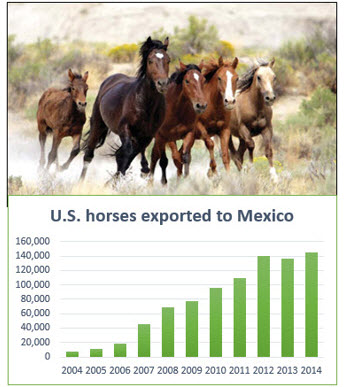WASHINGTON, Jan. 21, 2015 – As another winter grips the country, the plight of abandoned horses, often old and sick, and wild steeds roaming the West's public lands isn't likely to improve soon, say sources with animal welfare and horse organizations. The sorry state of the nation’s excess horses comes despite a host of new and expanded sanctuaries sponsored by horse rescue groups and the U.S. Bureau of Land Management, which manages wild horses for all federal agencies, plus the expansion of the BLM’s horse holding sites in recent years.

Also on the plus column, Gendron notes, “people are becoming more aware of horses in dire condition, and police are getting more attentive and are prosecuting abuse cases more often.”
But since Congress closed the last U.S. horse slaughter plants in 2007, the surplus horse population has grown markedly, especially for the wild herds of the West. BLM manages to adopt out very few of the wild mustangs and burros, and has stopped selling any that would be bound for slaughter. So recent tallies by the BLM and U.S. Forest Service indicate 56,000, or about 60 percent more than available forage can sustain. Further, the number of equines those agencies have in holding pens and fenced pastures has topped 50,000, or more than five times as many as at the start of this century.
What’s more, Western rancher groups such as Horses in Crisis say BLM greatly undercounts horses on federal lands. “Left without population control, the herds grow about 20 percent a year, so they double in four years,” says Dave Duquette, an activist with the group who also heads United Horsemen. Plus, he says, BLM’s numbers don’t include more than 100,000 surplus horses on Native American reservations, where the forage is grossly inadequate. Many tribes are desperate to reduce wild horse herds because they’re overgrazing pastures they need for their own livestock.

The result has been a collapsed market for both wild horses and privately owned old steeds, and their near-zero value only encourages abandonment, horse buyers say. Demand for such horses has been so lacking, says Jann Parker, a veteran Montana horse trader, that few auction barns hold horse sales any more. Still, she and Link Thompson, who trade horses in Nebraska, say the value of healthy, well-trained saddle horses has strengthened in the past year or so and now such animals can bring $5,000 or more.
One partial solution to the overpopulation problem -- giving wild mares contraceptives to cut the birth rates -- hasn’t had much affect so far, even though success with the darts and needle injections to prevent pregnancies is steadily improving.
Stephanie Boyles Griffin, an animal reproduction expert with the Humane Society of the U.S., says nearly 60 percent of mares in a wild herd usually bear young annually. Trials so far with new contraceptive darts, which contain an initial treatment and four boosters, show they work for up to three years if applied properly. But she says effective rates consistently at 90 percent or more are needed to achieve effective herd population control.
Dan Baker, a Colorado State University animal reproduction researcher, says a popular horse contraceptive vaccine – GonaCon – that was developed to give nearly all stabled mares two or three years without foaling, proved less than 50 percent effective when he treated a small wild herd in western North Dakota. He is trying booster shots to increase the effectiveness.
Meanwhile, horse slaughter and meat processing, a traditional relief valve to horse overpopulation since horses first came to America 500 years ago, probably won’t be restored soon. Congress has annually blocked horse meat inspection (thus, all sale of the meat as food). Also a suit by horse rescue groups, now before the U.S. 10th Circuit Court of Appeals, blocks USDA from inspecting horse meat as well.
Though Duquette says while advocates for reopening such plants “have a strong game plan” in the new Republican-controlled Congress, support on Capitol Hill to do just the opposite -- permanently ban horse slaughter -- has broad bipartisan support. A century ago, the U.S. horse herd was near 20 million, more than twice the current tally, and processing aged, lame and other surplus horses was traditional.
Meat plants still killed about 300,000 a year in the late 1980s. But more and more, Americans see horses as pets – as family members and not disposable. Plus most Americans shun horse meat. Horse slaughter is now an emotionally charged issue, and political and regulatory success to reopen slaughter plants is iffy at best.
Another upshot of halting the U.S. slaughter – besides growth in unwanted horses and sanctuaries – is soaring exports of live horses to Mexico. A few high-valued animals are sold there as breeding stock, but nearly all are trucked en masse for slaughter: around 140,000 annually in recent years, twice the count before U.S. slaughter plants were closed. Meanwhile, the pace of horses shipped to Canada, about 40,000 annually, is nearly twice that of a decade ago. Legislation is being considered that would ban horse exports for slaughter, but this would only exacerbate the horse overpopulation problem.
Still, there is a bright spot for horses this winter: Cheaper, more plentiful feed. Record harvests have corn, oats and other grains at their cheapest levels in years. More importantly for equines, 2014’s ample rains improved pastures, and hay stocks are up sharply while prices are down: The December U.S. farm price for alfalfa hay, at $182 a ton, was its lowest in four years. Paul Dugger, CEO of the National Hay Association, says excess rain did hurt the feed value of a lot of hay (delaying harvest, etc.) in the Northern Plains and Southeast especially, but U.S. horse owners have the easiest time in years finding and paying for feed.
#30

